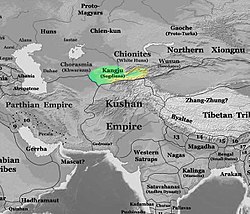Kangju | |
|---|---|
| 1st century BCE (?)–5th century CE | |
 The approximate territory of the Kangju c. 200 CE. | |
| Status | Independent state |
| Capital | Kangu |
| Common languages | Sogdian language |
| Historical era | Late Antiquity |
• Established | 1st century BCE (?) |
• Disestablished | 5th century CE |
| Today part of | Uzbekistan Tajikistan |
Kangju (Chinese: 康居; pinyin: kāngjū; Wade–Giles: K'ang-chü; Eastern Han Chinese: kʰɑŋ-kɨɑ < *khâŋ-ka (c. 140 BCE)[1]) was the Chinese name of a kingdom in Central Asia during the first half of the first millennium CE. The name Kangju is now generally regarded as a variant or mutated form of the name Sogdiana. According to contemporaneous Chinese sources, Kangju was the second most powerful state in Transoxiana, after the Yuezhi.[2] Its people, known in Chinese as the Kāng (康), were evidently of Indo-European origins, spoke an Eastern Iranian language, and had a semi-nomadic way of life. The Sogdians may have been the same people as those of Kangju and closely related to the Sakas,[3] or other Iranian groups such as the Asii.[4]
- ^ Schuessler, Axel (2014) "Phonological Notes on Hàn Period Transcriptions of Foreign Names and Words" in Studies in Chinese and Sino-Tibetan Linguistics: Dialect, Phonology, Transcription and Text. Series: Language and Linguistics Monograph. Issue 53. p. 272 of 249-292
- ^ Zadneprovskiy 1994, pp. 463–464
- ^ Sinor 1990, p. 153, 174: "... the Sogdians, known as K'ang-chü to the Chinese..."
- ^ Golden 1992, p. 53.